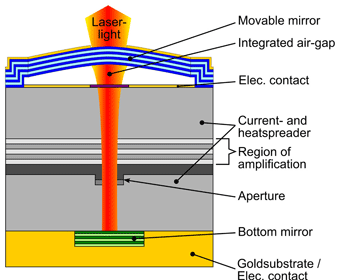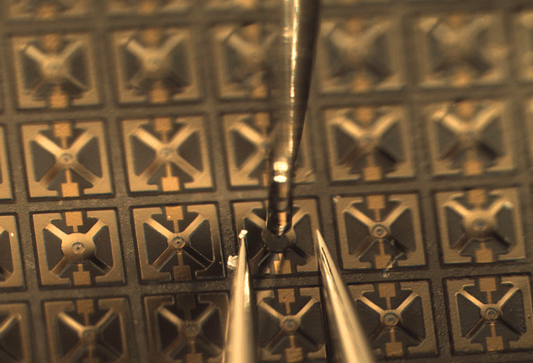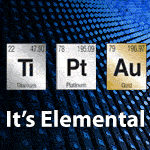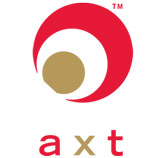- News
28 August 2012
TU Darmstadt develops 1.5µm VCSEL with record 100nm bandwidth, plus first tunable 2µm laser
In collaboration with partners in the EU project ‘Subtune’ (Widely Tuneable VCSEL using Sub-wavelength Gratings), researchers at Technische Universität Darmstadt have developed semiconductor lasers that emit light over a wavelength range of 100nm, which is claimed to be a record for a single semiconductor laser. Such lasers could allow more efficient, lower-cost operation of future fiber-optic telecoms networks and the development of high-responsivity gas sensors.
Since vertical-cavity surface-emitting lasers (VCSELs) emit light at a right angle to the plane of the substrate and require very little power for operation, they are used as light sources in, for example, computer mice and laser printers. Subtune’s aim was to develop InP-based long-wavelength VCSELs emitting at 1.5-2.0µm and GaAs-based VCSELs with wavelengths down to 800nm, targeting the introduction of widely tunable VCSELs in a broad range of the optical spectrum. Physicist Christian Gierl and materials scientist Karolina Zogal of TU Darmstadt’s Institute for Microwave Technology and Photonics have hence recently significantly extended the tunabilities of such lasers.
 Graphic: Design of TU Darmstadt's semiconductor laser. (Picture: Institute for Microwave Technology and Photonics.)
Graphic: Design of TU Darmstadt's semiconductor laser. (Picture: Institute for Microwave Technology and Photonics.)
Their approach involves taking advantage of another benefit of surface-emitting semiconductor lasers, namely their very large resonator-length/emitting-area ratios, which greatly increases the spacings of their emitted wavelengths. Their broad free spectral range allows tuning of the wavelength of their strongest emission line over a broad range, i.e. converting them into transmitters whose output may be set to any wavelength falling within a certain, broad range.
Gierl and Zogal managed to tune the wavelength of the output beam of a semiconductor laser (provided by Subtune project partner Walter Schottky Institute at TU-München) over a range of more than 100nm (reckoned to be the broadest tuning range achieved by any semiconductor laser) while retaining other emission characteristics such as its high output power and high spectral purity.
To obtain that broad tunability, they applied to its emitting surface a flexible membrane (with a reflectance exceeding 99% at its lasing wavelengths) that served as its output mirror, and whose flexing could be externally controlled. Since every laser is equipped with a pair of facing mirrors (reflecting the light back and forth, for amplification by the laser’s active medium on each pass), the spacing of the mirrors determines which wavelengths from the amplified range are emitted. In the new lasers, the active component (half-VCSEL) is combined in a hybrid two-chip assembly with a bulk-micromachined movable mirror membrane that can be actuated electrothermally to expand the air-gap. This allow the spacing to be varied accurately and the laser output wavelength to be tuned smoothly over a broad range by shifting the cavity resonance towards longer wavelengths.

Picture: Such lasers may allow more efficient, lower-cost operation of future fiber-optic telecoms networks and the development of high-responsivity gas sensors. (Picture: Institute for Microwave Technology and Photonics.)
The lasers are tunable over a range centered on 1.5µm (the wavelength used by fiber-optic telecom systems). The researchers have also developed what is claimed to be the first tunable laser covering a range centered on 2.0µm.
“The telecommunications industry is extremely interested in this technology because in the future it will need to service households via fiber-optic networks operating at various wavelengths,” says Gierl. “If there were no tunable lasers, a special type of semiconductor laser would have to be fabricated for each wavelength to be involved,” he adds. “Tunable lasers obviate that necessity, since only a single type of laser will have to be fabricated.”
The wavelength range centered on 2.0µm is of particular interest to sensors for detecting the presence of gases, since it falls within the range where the vibrational modes of molecules (such as carbon dioxide) are excited. Gases may be identified and their concentrations determined by means of precision measurements of the wavelengths at which they absorb radiation and the absorption coefficients occurring at those wavelengths. “Since that absorption is very strong, gas sensors based on our technology have high responsivities, in addition to being extremely compact and highly energy-efficient,” says Gierl. Again, due to their tunability, a single laser will be sufficient for detecting various gases.
According to the researchers, another benefit of the new lasers is that they are easy to fabricate. “Although the method we employ for applying the membrane directly to the laser is new, we utilized methods [microphotolithography] that have become well established in the semiconductor industry for that purpose,” says Gierl. “We are able to fabricate chips having numerous, tunable, surface emitters that meet all of the requirements for the particular applications involved,” he adds.
A follow-on project is intended to close the remaining gaps in readiness of such chips for practical applications. Closing one of those gaps involves enabling their output to be modulated at high frequencies so that data can be transmitted at high transfer rates. The researchers also plan to incorporate their chips into modules similar to USB sticks that may be readily integrated into telecoms systems. They are already collaborating with Lawrence Livermore National Laboratory in California and with Leister Technologies AG of Kaegiswil, Switzerland on improving their gas sensors. Furthermore, the new lasers have already been tested on a communications network at Subtune project partner Tyndall National Institute in Cork, Ireland.
InP VCSEL GaAs VCSEL Tunable laser





